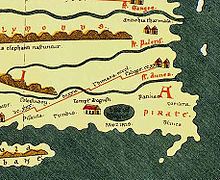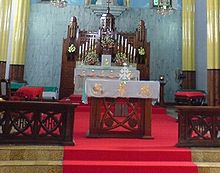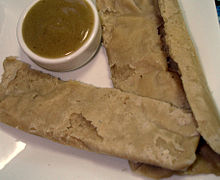- Knanaya
-
Main article: Syrian Malabar Nasrani
Knanaya
(קנאי Q'nai or Kanai)Total population 50,000–65,000 (estimate) Regions with significant populations  India
India20,000–25,000  United States
United States20,000–25,000  United Kingdom
United Kingdom5,000–7,000  Kuwait[1]
Kuwait[1]3,000  Canada
Canada3,000  Italy[2]
Italy[2]2,000  Austria[3]
Austria[3]<1,000  Switzerland[4]
Switzerland[4]<1,000  Ireland[5]
Ireland[5]<500  Germany[6]
Germany[6]<500  Israel[7]
Israel[7]<100 Languages Historical: Hebrew, Aramaic[8]
Modern: Local languages, primarily: Malayalam, English, ArabicReligion Predominantly Knanaya Catholic; largest minority: Knanaya Jacobite; other religions
Related ethnic groups Syrian Malabar Nasrani, Cochin Jews, Yemeni Jews and Malayalis.
The Knanaya (Hebrew: חנניה, Malayalam: ക്നാനായ, Syriac: ܛܢܢܐ, Arabic: قينان) also known as Q'nanaya, Q'nai, Kanai, or Thekkumbagar, are endogamous Jews who settled in Kerala, India.[9][8] Their origins are unclear and are hotly disputed by academic scholars. Many believe them to be in fact descendants of Yemeni Jews who once formed a significant component of the Cochin Jewish population up until the sixteenth century. The Knanaya people lived in Kodungallur and were wealthy plantation owners, merchants and bankers until an assault by Muslims. This led to the Knanaya people fleeing south for refuge to places like Kottayam and Thiruvananthapuram.
During the Portuguese occupation of Kerala, the Knanaya people were heavily persecuted for their Jewish beliefs. As a result of the Portuguese occupation the Knanaya population dwindled significantly, Knanaya artifacts and culture were lost, and caused the formation of two groups - Knanaya Catholics and Knanaya Jacobites. Many Knanaya later migrated at the start of the 20th and 21st century, largely westward, forming communities in non Malayalam-speaking areas, including the United States, United Kingdom, Kuwait, Canada, and Italy. With the the vast majority of Knanaya people moving westward; the number remaining in Kerala itself is in decline.
Their endogamous belief has also led to several demographic problems including an alarming rate of cousin marriages as well as a raise in people choosing not to follow endogamy. Their claim as Jews has also stirred controversy as their beliefs no longer resemble Judaism but rather Jewish Christianity.
Contents
Etymology
Knanaya literally means "Q'nai people" or "Kanai people". It corresponds to the Aramaic word ܛܢܢܐ meaning "zeal". Knanaya suggests a shift between Syriac ܛ and Malayalam ക. It also suggests a common origin with the Hebrew term קנאי (Q'nai or Kanai) meaning "overly-jealous" or "with-zeal". The plural form is קנאים (Kna'im). The first use of the term kanai in the Tanakh is with Pinchas.
However, prior to the popularity of Knanaya, Thekkumbhagar, Malayalam for "Southists" was often used to describe the community. This was coined because they lived in the southern part of Kerala. Today the term Thekkumbhagar is rejected and viewed unfavorably, with a preference to identify themselves as Knanaya.
History
Origin and migration
Prior to the migration to Kerala, very little is actually known about the Knanaya people. Notably Knanaya have claimed to be from various locations in the middle east including Jerusalem, Israel, Syria, Iraq, and Şanlıurfa, Turkey.[10] There is no mutual agreement from where Knanaya lived before their arrival to Kerala. [11]
 It is a long-standing tradition among Knanaya that they sailed to India under a flag of the Magen David.[12]
It is a long-standing tradition among Knanaya that they sailed to India under a flag of the Magen David.[12]
It is generally believed by Knanaya people that 72 families with a total of 400 people migrated to the Malabar coast in AD 345, under the leadership of a prominent merchant Knai Thomman. They sailed in three ships headed by a leading ship under the flag of the Magen David to Muziris. The Knanaya were granted asylum and permission to engage in trade and settle down in Kodungallur by the then ruler of Malabar, Cheraman Perumal.[12] The event was recorded on copper plates given to the community.[12] In Kodungallur, they established 72 houses.[12] It also can be noted that Knanaya do not agree why they came to Kerala. Persecution by the Romans, missionary efforts, and for the wealth of the spice trade have all been suggested.
The validity of this story is contested by scholars. There are no documented evidence of such a community existing until the 16th century. Interestingly, it is also same time when a dispute broke out between dispute over chieftain-ship broke out between two brothers, one of them named Joseph Azar, in the Yemeni Jewish community, a component of the Cochin Jews. Scholars have also noted the striking similarity between the Knanaya and the Yemeni Jews or the Black Jews of Kerala. Yemeni Jews are believed to have arrived in Kerala at about roughly the same time. They were led by Joseph Rabban a merchant through Muziris. They were given the rights to seventy-two houses in Kodungallur.[13] The Hindu king, Cheraman Perumal, gave them approval for the Jews to live freely, construct synagogues, and acquire land.[14][15] This was all documented on a pair of copper plates granting the community special privileges. [16] The striking parallels have led many to speculate that the Knanaya are in fact the Yemeni Jews who split to form their own community.
 Knanaya folklore states that they sailed through Muziris.
Knanaya folklore states that they sailed through Muziris.
Pre-colonial
Most of the Knanaya had remained in Kodungallur. They had become wealthy pepper plantation owners, merchants, or bankers. The Knanaya maintained close relationship with the Cochin Jews in the early 1500s.[17] The growing Muslim population caused increasing tension with Knanaya. The Caliphate sought the wealth accumulated by the Knanaya and led assault upon Kodungallur. The Caliph's mercenaries captured Kodungallur which caused an exodus of Knanaya people fleeing for refuge in the south to Kaipuzha, Kottayam, Kozhikode, and Thiruvananthapuram. Those who remained in Kondungallur were forced to convert to Islam. Notably the, Hawariyun (حواريون) share Knanaya ancestry [18].
Persecution by the Portuguese
Main article: Portuguese InquisitionWith the arrival of the Portuguese to Kerala, the Knanaya were denounced and persecuted for their Jewish beliefs. The Nasranis and Cochin Jews were also targeted. An imperial order was passed to confiscate and sell under public auction the properties of those who celebrated Passover and Sukkah. Furthermore, circumcision was prohibited as was reading and writing in Hebrew and Aramaic.[19]. Ancient Knanaya artifacts and texts were confiscated and burned by the Portuguese as to destroy the Jewish identity of the Knanaya people. In some rare instances, Knanaya who were caught defying the imperial order were executed. The oppressive rule by the Portuguese was sometimes met with resistance. These movements were futile as the Portuguese swiftly punished Knanaya who protested with death.
The Knanaya fell victim to the Portuguese missionary efforts to Christianize them. They were forced to incorporate European changes including Mariolatry into their ancient fidelity. Despite the all this, the Knanaya managed to preserve some elements of their Jewish customs, because of their endogamous practice and decision to become Crypto-Jews.[11] This is why Knanaya continue to celebrate Passover very privately without inviting any Christian friend to share the Holy Meal.[20] Still majority of their Jewish ethos was lost. [19] As a result of the Portuguese occupation, the Knanaya divided in two groups - Knanaya Catholics and Knanaya Jacobites.
Distortion of history
During the 19th and 20th centuries several Knanaya religious leaders came together and attempted to comprehensively rewrite Knanaya history. Severios, one of the leaders involved had been quoted stating his aims clearly. He wanted to boost the Knanaya from being a people with a past to one with a “glorious” past.[21] This attempt meant changing the Yemeni Jewish identity to a Syriac Jewish Christian one. As a result of this, much of actual Knanaya history has been lost.
Modern era
Many Knanayas began migrating at the birth of the 20th and 21st century, largely westward, forming communities in non Malayalam-speaking areas, including the United States, United Kingdom, Kuwait, Canada, and Italy. With the the vast majority of Knanaya people moving westward; the number remaining in Kerala itself is in decline. Even today, Knanaya are still victims of increasing missionary efforts from both Christian and Islamic missionaries desiring that they should abandon their Jewish identity, customs, and traditions.
Religion
As a consequence of the Portuguese occupation, Knanaya are split into two major groups.[22] Knanaya Catholic was established as a result of the arrival of the Portuguese. A Knanaya Syriac Orthodox diocese was established in 1910, which reports directly to the Patriarch of Antioch of the Syrian Orthodox Church. The Knanaya Catholics and their Jewish identity and practices was acknowledged by the Vatican under Pope Pius X, by establishing in 1911 a separate diocese for the Jewish Christians, named the Knanaya Catholic and headed first by Mar Mathew Makil.[22][23] However there status as Jews is still not acknowledged by Israel as they have abandoned Judaism with a Jewish Christian belief. There are a sizable population of Knanaya who are irreligious or practice some other faith.
The order of their Qurbana (l'todah u'zevach shelamim) is as outlined in VaYikra. The kiddushin or betrothal is the first step in Knanaya marriage. The bridal canopy or chuppah is an essential part of the Knanaya wedding ceremony and there is a ceremonial bathing on the eve of the wedding that resembles the mikvah. The dead are buried facing the east (though Jerusalem is west of India).[17] Thanksgiving blessings which the Knanaya use which follow the Hebrew formula, Birkat HaMazon (ברוך אתה ה' א‑לוהינו מלך העולם, המוציא לחם מן הארץ).
Culture
Knanaya culture is closely related to Indian as well as Jewish. While many of their Jewish roots were lost, some still linger. Cultural contributions express the distinctiveness of the Knanaya experience. There are many Jewish customs recorded in the Peshtta still preserved by the Knanaya.[17]
Cuisine
Knanaya's history of rule by the Portuguese and settlement in India is reflected in Knanaya cuisine, which has benefited from various cultural exchanges and contributions. Honey yeast cakes and Halwa is a popular desert item among Knanaya.
One such Knanaya Jewish cuisine preserved, is the consumption of Pesaha pal (passover coconut milk [חלב קוקוס]) on the night of Passover along with Pesaha-appam (unleavened passover bread).[17] This tradition of Pesaha appam was observed by the entire Nasrani people until Portuguese persecution as well as the Cochin Jews.[17]
Endogamy
Knanaya people are infamous for their strict endogamous practice. Knanaya reject the idea of conversion though, Agape shelamim is a means of communion with the community.
The stringent endogamous belief has caused several demographic problems such as a steady raise in cousin marriages. The limited gene pool also has caused worry as it means increased chances for genetic disorders as well as a reduction in genetic diversity. The increasing amount of people choosing not to follow endogamy has also been a concern.
There are many critics of the endogamous practice, both Knanaya and non-Knanaya. The practice is often described as racist or supremacist custom. While those in favor argue that it is necessary to preserve the Knanaya. A recent controversy had occurred in the community's refusal to accept adopted children belonging to a Knanaya couple who were unable to have children.
There is also an argument about how strict the endogamous practice has been in the past. DNA tests have confirmed that the community has had significant admixture with the local population. Further more it has been illustrated that other Jews have joined the community as genetic testing indicates was certainly allowed in the past.
Music
Knanaya music has historically been associated with worship, marriage, and folklore. Many Knanaya songs were passed down from generation to generation and with that, changes were made to adapt to the Indian surroundings. Many folklore songs detail the journey of the Knanaya people through time and is one of the main sources used to tell Knanaya history. These traditional songs have now been recorded and re-imagined by various musicians. Recently, a new wave Knanaya musicians have begun to experiment with other genres due to the Knanaya exodus west and have begun collaborating with non-Knanaya artists.
See also
- Kanahi
- Syrian Malabar Nasrani
- Cochin Jews
- Yemeni Jews
Notes
- ^ "Kuwait Knanaya". http://www.kuwaitknanaya.com/.
- ^ "Knanay Milan". http://knanaymilan.com/. Retrieved 26 October 2011.
- ^ "ViennaKnas.com". http://www.viennaknas.com/. Retrieved 1 January 2009.
- ^ "Swisskna.com". http://swisskna.com/. Retrieved 1 January 2009.
- ^ "German Ireland". http://www.knanaya.de/. Retrieved 26 October 2011.
- ^ "German Knanaya". http://www.knanayaireland.com/. Retrieved 26 October 2011.
- ^ "Knanaya's Around the World". Knanaya's of Israel. http://www.jpost.com/servlet/Satellite?cid=1204473063867&pagename=JPost%2FJPArticle%2FShowFull. Retrieved 3 March 2008.
- ^ a b Menachery G. 1973, 1998; Vellian Jacob 2001; Weil,S. 1982; Podipara, Placid J. 1970
- ^ Richard M. Swiderski Blood weddings: the Knanaya Christians of Kerala 1988
- ^ Mcfadden, Robert D.; Mcgeehan, Patrick (24 November 2008). "Gunman Kills One at a Church in New Jersey". The New York Times. http://www.nytimes.com/2008/11/24/nyregion/24church.html?em.
- ^ a b Menachery G; 1973, 1998; Weil, S. 1982; Poomangalam C.A 1998; Thomas Puthiakunnel 1973; Vellian Jacob 2001; Koder S. 1973
- ^ a b c d Menachery G; 1973, 1998; Weil,S. 1982; James Hough 1893; Thomas Puthiakunnel 1973; Vellian Jacob 2001; Koder S. 1973
- ^ taken from WP article on Rabban, which appears to rely on Ken Blady's book Jewish Communities in Exotic Places. Northvale, N.J.: Jason Aronson Inc., 2000. pp. 115–130.
- ^ Three years in America, 1859–1862(p.59,p.60)By Israel Joseph Benjamin
- ^ Roots of Dalit history, Christianity, theology, and spirituality(p.28) By James Massey, I.S.P.C.K.
- ^ (Burnell, "Indian Antiquary," iii. 333–334)
- ^ a b c d e Weil,S. 1982; Jessay, P.M. 1986; Menachery G; 1973, 1998; Thomas Puthiakunnel 1973; Vellian Jacob 2001; Koder S. 1973; Vellian, J 1988
- ^ http://www.knanayacatholics.com/articles/chapter1.htm
- ^ a b Claudius Buchanan, 1811
- ^ http://knanaya.weebly.com/who-is-a-knanaite.html
- ^ Alexander M. Mapleton Knanaya Catholics 2010
- ^ a b Weil, S. 1982; Jessay, P.M. 1986; Menachery G; 1973, 1998; Vellian Jacob 2001
- ^ brief set of bios of bishops of Kottayamad
References
- Menachery, G. (1973) The St. Thomas Christian Encyclopedia of India, Ed. George Menachery, B.N.K. Press, vol. 2, ISBN 81-87132-06-X, Lib. Cong. Cat. Card. No. 73-905568 ; B.N.K. Press
- Vellian, Jacob (2001) Knanite community: History and culture; Syrian church series; vol.XVII; Jyothi Book House, Kottayam
- "In Universi Cristiani" (Latin Text of the Papal erection of the Knanaya Diocese of Kottayam)
- Puthiakunnel, Thomas. (1973) "Jewish colonies of India paved the way for St. Thomas", The Saint Thomas Christian Encyclopedia of India, ed. George Menachery, Vol. II., Trichur.
- Koder, S. (1973) "History of the Jews of Kerala".The St. Thomas Christian Encyclopaedia of India,Ed. G. Menachery.
- Vellian, J (1988) Marriage Customs of the Knanites, Christian Orient, 9, Kottayam.
- Weil, S. (1982) "Symmetry between Christians and Jews in India: The Cananite Christians and Cochin Jews in Kerala. in Contributions to Indian Sociology, 16.
- Jessay, P.M. (1986) "The Wedding Songs of the Cochin Jews and of the Knanite Christians of Kerala: A Study in Comparison." Symposium.
- James Hough (1893) "The History of Christianity in India".
- Menachery, G (ed); (1998) "The Indian Church History Classics", Vol.I, The Nazranies, Ollur, 1998. [ISBN 81-87133-05-8].
- Poomangalam, C.A. (1998) The Antiquities of the Knanaya Syrian Christians; Kottayam, Kerala.
- Podipara, Placid J. (1970) "The Thomas Christians". London: Darton, Longman and Tidd.
External links
Categories:- Christian and Jewish interfaith topics
- Kerala society
- Knanaya Community
- Malayali people
- Jewish history
- Groups claiming Jewish descent
- Semitic peoples
Wikimedia Foundation. 2010.


